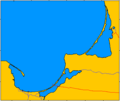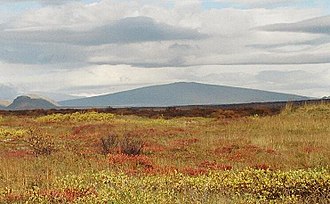AY Honors/Geology/Answer Key
1. Give the geological meaning of the following words:
- a. Delta
- A delta is a landform where the mouth of a river flows into an ocean, sea, desert, estuary or lake.
- b. Sand spit
- A spit a deposition landform found off coasts. A spit is a type of bar or beach that develops where a re-entrant occurs, such as at a cove, bay, ria, or river mouth. Spits are formed by the movement of sediment (typically sand) along a shore
- c. Sinkhole
- A sinkhole is a natural depression or hole in the surface topography caused by the removal of soil or bedrock, often both, by water. Sinkholes may vary in size from less than a meter to several hundred meters in diameter and depth, and vary in form from soil-lined bowls to bedrock-edged chasms. They may be formed gradually or suddenly, and are found worldwide.
- d. Oxbow lake
- n oxbow lake is a type of lake which is formed when a wide meander from a stream or a river is cut off to form a lake. They are called oxbow lakes due to the distinctive curved shape that results from this process. In Australia, an oxbow lake is called a billabong.
- e. Moraine
- Moraine is a French word that refers to any glacially formed accumulation of unconsolidated debris. This debris may be plucked off the valley floor as a glacier advances or fallen off the valley walls as a result of frost wedging. Moraine may be comprised of silt like glacial flour to large boulders. The debris is typically angular. Moraine may be on the glacier’s surface or deposited as piles or sheets of debris where the glacier has melted. Moraine may also occur when rocks fall in the sea.
- f. Cirque
- A cirque is an amphitheatre-like valley (or valley head) of glacial origin, formed by glacial erosion at the head of the glacier. Cirques are typically partially surrounded by steep cliffs. The highest cliff is often called a headwall. They are also known as a cwm in Wales, a coomb or coombe in England, and a corrie in Scotland and Ireland.
- g. Mesa
- A mesa (Spanish and Portuguese for "table") is an elevated area of land with a flat top and sides that are usually steep cliffs. It takes its name from its characteristic table-top shape. It is a characteristic landform of arid environments, particularly the southwestern United States. Many examples are also found in Spain, North and South Africa, Arabia, India, Australia, and the Badlands and Colorado regions of North America.
- h. Alluvial fan
- An alluvial fan is a fan-shaped deposit formed where a fast flowing stream flattens, slows, and spreads typically at the exit of a canyon onto a flatter plain.
- i. Anticline
- An anticline is an upward-curving fold, with layers that rise from the center of the structure.
- j. Syncline
- A syncline is a downward-curving fold, with layers that dip toward the center of the structure. It's easy to remember which is an anticline and which is a syncline, because the syncline "sinks" in the middle.
2. Describe the following:
a. A shield-type volcano as compared to a composite volcano
A shield volcano is a large volcano with shallowly-sloping sides. Shield volcanoes are formed by lava flows of low viscosity — lava that flows easily. Consequently, a volcanic mountain having a broad profile is built up over time by flow after flow of relatively fluid lava issuing from vents or fissures on the surface of the volcano. Many of the largest volcanoes on Earth are shield volcanoes. The largest is Mauna Loa on the Big Island of Hawaii.
A composite volcano is a tall, conical volcano composed of many layers of hardened lava, tephra, and volcanic ash. These volcanoes are characterized by a steep profile and periodic, explosive eruptions. The lava that flows from them is viscous, and cools and hardens before spreading very far. Mount St. Helens in Washington, USA, Popocatépetl in Mexico, and Krakatoa in Indonesia are composite volcanos.
b. How a glacier moves and what evidences it leaves behind
c. How sediments are laid down by water
d. The different types of mountains
e. Why a river or stream bank often keeps caving in on the outside of a bend
3. Know what category of rocks (sedimentary, metamorphic, or igneous) the following rocks are:
a. Granite
b. Sandstone
c. Conglomerate
d. Slate
e. Shale
f. Marble
g. Lava
h. Limestone
i. Basalt
j. Gneiss
4. Take a picture or make a sketch of each of the following geological features:
a. A bed of sediment that is coarser at the bottom and finer toward the top (This is called normal graded bedding.)
b. Ripple marks in sand or mud (Show with an arrow the current direction if possible.)
c. Gulley erosion
d. Mud cracks (These can usually be found after a heavy rain or flood when mud starts to dry.)
e. Soil profile along a stream bank or road cut (You should be able to see how soil usually becomes lighter colored downward from the surface of the ground.)
f. Sand bar (Sand bars can be found in rivers or streams, or along the ocean.)
References
- Wikipedia articles











